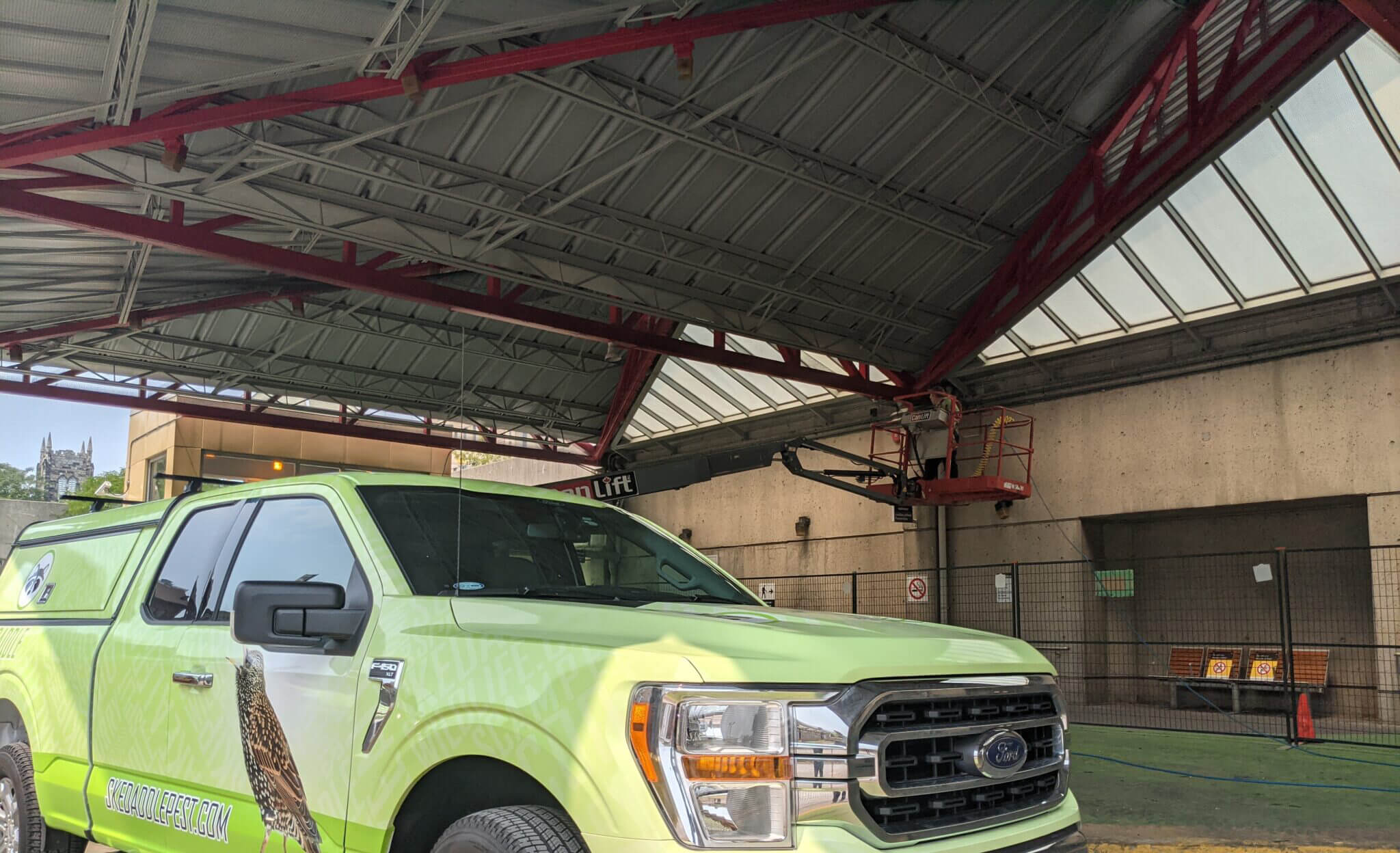BIRD REMOVAL PROCESS
Assess and Remove
The first step in resolving a nuisance bird issue is a thorough understanding of the exact nature of the problem. Our customized removal plans take into account the species of bird involved, the affected areas of the home and measures to prevent future incidents.
Clear and Clean
Birds can be messy, their nesting material and droppings can cause home damage and result in unsanitary conditions. As part of the process our trained technicians will remove nests from vents, soffits and balconies and safely scrub away unhealthy droppings.
Prevent and Protect
Our prevention plans are customized to address the specific bird threats your home or business faces. Our technicians are trained to install protective barriers and deterrent devices designed to make your home or business inhospitable to birds.
Bird Removal Hamilton
There have been 501 bird species identified in Ontario, with 291 of them using the province as their breeding grounds. Many of those birds pass through or call Hamilton home, the diversity in bird behaviour, life cycle and physical features make the city a playground for bird watchers. However, anyone that has taken a walk through Hamilton’s Bayfront Park, where grazing Canada Geese leave behind high volumes of droppings, knows that congregating birds can quickly create unsafe conditions. When birds get close enough to make their nests in your chimney, vents or attic, the mess they leave behind can lead to property damage and health hazards.
Hamilton’s Best Nesting Grounds
Birds thrive in locations with close access to water, food sources and abundant nesting grounds. Hamilton’s location along the shores of Lake Ontario makes it an ideal destination for both gulls and Canada Geese. Closer to the downtown core, you’re much more likely to find pigeons roosting on the balconies and ledges of the buildings surrounding Gore Park.
Both homes and businesses offer bird species the ideal perch to hide from the elements and predators. Lily, Hamilton’s famous peregrine falcon, was able to thrive by nesting on the Sheraton Hotel for seven years. In 2022, residents selected the peregrine falcon as Hamilton’s city bird, a symbol of Hamilton’s ability to help bird populations thrive.
Home and business owners throughout Hamilton struggle to keep birds away from their property once they begin to shelter for the winter or nest and raise babies in the spring. Vents, rooftops and balconies offer great protection from cold temperatures and predators.
Hamilton’s Wild Bird History
Today Hamilton strives to be a bird-friendly city but that was not always the case. Way back in 1954, in an effort to limit rising bird populations, city officials and members of the city’s Starling and Pigeon Committee brought together a group of 122 hunters whose objective was to shoot as many starlings as they could. The bird shoot took place in Gore park and over 4,500 birds were killed when the shooting stopped.
Today, starlings and many other bird species are still a nuisance to many home and business owners in Hamilton and there is general recognition among the public that eliminating birds all together is not the answer. Many bird species have adapted to our urban environment and in most cases the best way to resolve and prevent problems is through habitat and behaviour modification. Skedaddle’s humane deterrents are customized to the specific factors that are causing the problem and encourage birds to find a new home without killing them in the process. Installing secure exclusion methods is the only way to keep nuisance birds from damaging your home and property.
Skedaddle Understands Hamilton Birds
Since 1989 our technicians have been humanely removing birds from home and business throughout some of Hamilton’s oldest and newest neighbourhoods. One of the most common bird issues for homeowners in newly developed residential communities, such as Binbrook and Waterdown, arises from starlings nesting in vent openings found on the exterior walls of homes. Starlings are cavity nesters and make their way into kitchen, dryer and bathroom exhaust vents with ease. Once inside, they build nests to lay eggs, stuffing the vent full of dry twigs and grass and introducing bird mites and droppings. Understanding how to safely remove starlings, their babies and clean out the vent requires a professional hand.
Much like Hamilton homeowners, business owners in the city are no stranger to bird problems. Large signage and specious roofs provide pigeons, starlings and sparrows with an ideal nesting ground. In 2021, the Hamilton GO Centre was infested with a large number of pigeons roosting and nesting on steel beams above a high traffic bus platform. Skedaddle technicians were able to successfully install thousands of square feet of netting to prevent the birds’ ability to access the area while keeping travelers safe as they passed through. “At Skedaddle, we are always happy when our services can provide community members with safe spaces, while encouraging peaceful coexistence with urban wildlife”- Bill Dowd, Skedaddle President & CEO. Our commitment to protect local birds in Hamilton and educate community members about the importance of humane removal methods is aided by our partnerships with the Hamilton/Burlington SPCA as well as the Burlington Humane Society.

Using a safety lift, Skedaddle technicians carefully install thousands of square feet of netting above common walkways in the Hamilton GO Centre.
Skedaddle is trained to handle all bird problems, big or small. Our technicians have the expertise and equipment to provide business and homeowners with a quick solution. Ensuring the safety of your property and everyone on it takes skill and knowledge, which is why it is always best to enlist the help of our experts who specialize in bird removal in hamilton.
What Hamilton Birds Do Through The Seasons
The sound of chirping birds is one of the first signs of spring. As the weather warms and food sources become more plentiful, birds begin to nest and lay their eggs. Depending on the species, eggs can hatch anywhere from one to three weeks after being laid, and once the chicks are born they will be dependent on their nest and parent’s daily feedings for survival. Spring and summer are the busiest times of year for bird removal services as many homes provide an ideal nesting ground. As babies grow, a significant amount of damage can be caused to the vents they nest in. Droppings, dry nesting materials, fleas, ticks and harmful bacteria are some of the harmful contaminants that birds bring with them.
During winter, many of Ontario’s birds have flown the coop and headed for warmer climes down south. Even so, more than 60 species stick around to tough out the long, cold Canadian winter. After bulking up their fat stores in the fall, birds that stay in cold winter temperatures must seek a warm place to shelter from the cold elements. Keep your eyes peeled this winter for evidence of birds in your attic, chimney, roof and wall vents, as these locations offer great protection from the cold, snow and ice. Pigeons are so well adapted to the cold they are capable of laying eggs even during winter.
Bird Facts
Birds who set up camp in your attic or vents can leave behind a mess of excretions. Their droppings, if handled unsafely, have the potential to pose serious health risks. Starlings, sparrows and pigeons are all potential carriers of various diseases, such as cryptococcosis and salmonellosis, which is primarily transmitted to humans via their droppings. Skedaddle Humane Wildlife Control specializes in bird removal in Hamilton. Our experienced technicians have the skills and tools needed to safely remove any unwanted birds, and prevent future incursions.
FACT:
Each year, The Hamilton Naturalists’s Club keeps detailed records of bird sightings in and around the city. Hamilton is a major seasonal stop and breeding ground for 368 different bird species.
FACT:
All starlings in Hamilton, and indeed throughout North America, are descendants of starlings released by Eugene Schieffelin in Central Park, New York City in 1891. Schieffelin was a Shakespeare enthusiast, who wanted to introduce all of the birds mentioned in Shakespeare’s poems to North America.
FACT:
Starlings, sparrows and pigeons are the most common species to build their nests in human structures. Their messy nests can be located in chimneys, soffits, roof vents and wall vents. Signs of their presence include damaged vents, staining from droppings and leaves and twigs poking out of openings.
FACT:
In 2020, Hamilton became the third destination in Ontario to be deemed a “Bird Friendly City”. This title was awarded by Nature Canada in order to bring awareness to Canadians about declining bird populations throughout North America.
FACT:
The pileated woodpecker is the largest North American woodpecker. It lives in wooded areas and can sometimes be spotted in parks. This beautiful bird leaves behind a rectangular hole in trees from its efforts to secure insects for food. Woodpeckers can also cause damage as they nest in stucco and wood sided homes. Woodpeckers are protected by the Migratory Bird Act.
FACT:
The rapid decline of the bald eagle was reversed through the ban of DDT along with serious conservation efforts. As such, Southern Ontario is now home to nearly 40 pairs of breeding bald eagles, though the bird is still considered endangered.
CHECK OUT OUR LATEST BLOGS
The True Cost of Ignoring a Bird Infestation in Your Attic
Bird Mites: The Hidden Danger of Nests in Your Eaves
What Types Of Birds Could Be Nesting In Your Hamilton Home?
Hamilton Wildlife Control: The Mysteries of Bird Nesting Habits
Hamilton Wildlife Removal: Managing Nuisance Birds in Residential and Commercial Areas





